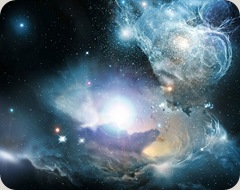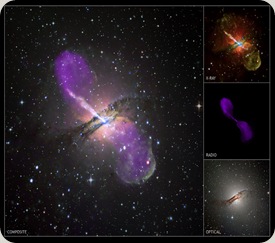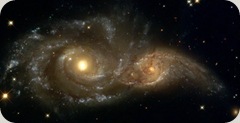Thursday, July 29, 2010
Dark matter and the far future
Tuesday, July 27, 2010
The big bang
Monday, July 26, 2010
Galactic black holes
The source of energy for all these different types of active galaxy is almost certainly a black hole. When a typical galaxy was formed, some of the stars near the center fell together and merged to form a massive black hole. For perhaps 50 million years this black hole swallowed stars, gas and dust, emitting vast quantities of radiation as it did so. Then the matter at the core of the galaxy was used up and the quasar faded. Quasar activity flared up and died away in galaxies over a two billion year period.
Tuesday, July 20, 2010
Super Clusters and Active Galaxies
Counts of galaxies show that the clusters are themselves grouped into” super clusters” chains and sheets separated by apparently empty voids, and measuring hundreds and thousands of millions of light years across. Whether this frothy texture of the universe was present in the gas from which the proto galaxies condensed, or whether the galaxies gathered into these structures after their formation, is still not understood.
At the heart of any nearby galaxies, and of the Milky Way, there seems to be great activity, hidden behind dense gas clouds. Stars are being whirled around by intense gravitations fields, and high energy X ray radiation is being emitted. In some galaxies there is even greater activity, and these can be detected at greater distances.
Many active galaxies are throwing out great jets of radiation together with charged particles which show up clearly at radio wavelengths the jets collide with the intergalactic gas and are halted to form puffs of radio emitting matter, called radio lobes, mainly consisting of fast moving charged particles but including a  scattering of stars.
scattering of stars.
The most intense activity is showing by the quasars, the nearest of which is two billion light years from us. A quasar is a quasi-stellar object, that is it looks like a star, but radiates in other regions of the electromagnetic spectrum like a galaxy. Not only can we see more quasars at great distances, because they are so bright, but the really are more. Most are found so far away that their light left them about eleven billion years ago- only a few billion years after the Big Bang. The outpouring of radiation seems to come from a tiny region at the centre of a galaxy.
Sunday, July 18, 2010
Groups of Galaxies
Saturday, July 17, 2010
The local group of Galaxy
Thursday, July 15, 2010
Structure of the galaxy
Wednesday, July 14, 2010
Evolution of Galaxy
Friday, July 9, 2010
Multiple Stars
Thursday, July 8, 2010
Supernovae
Monday, July 5, 2010
Types of Stars
Saturday, July 3, 2010
Stars and Nebulae
Gas in the galaxy is pretty much the same as the primordial matter that emerged from the Big Bang, and from which the galaxy formed perhaps 12 billion years ago. Three quarters of its mass consists of hydrogen, nearly all the rest of helium, but some of the gas and all of the dust consists of new elements formed since then in stars. The hydrogen, though dark, can be mapped by ultra high frequency radio emissions.




















































